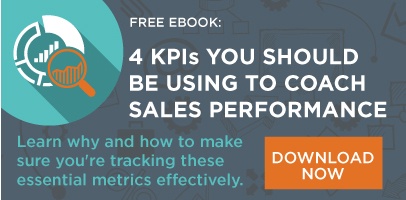
Ask any sales manager, salesperson, or business leader about CRMs and you’re likely to get mixed reviews. Most agree they are a necessary piece of technology, but that’s about all they might agree on. Managers tend to feel like they must have a CRM for proper reporting, but they've likely had a bad experience in the past due to lack of adoption by sellers. At the same time, many salespeople have had at least one poor experience with a CRM in their career. Meanwhile, a lucky few have found the key to effective and successful CRM adoption and usage.
Why is this? Why do CRMs feel like a necessary evil to so many sales organizations?
The short answer is because they are often customized, set up, and created for managers, but the effectiveness of CRMs relies almost entirely on the sales teams. Their usage, needs, and experience are oftentimes an afterthought for not only the CRM software company but also those put in charge of rolling out a CRM within an organization. This isn’t their fault, though. They are expected to report to business leaders who want a centralized database and accurate reporting. Everyone is worried about tracking activity, revenue, and conversions, as they should be.
But what do salespeople want? Well, they want to do exactly what we want them to do... to sell!
CRMs historically weren't created to help sellers sell. This is where the thinking behind the HubSpot CRM broke the mold (which you can read more about here). But even CRMs that are designed primarily for management can be used effectively to facilitate the sales process. What's holding sales teams back? Let’s look at the top five reasons salespeople aren’t using their CRMs effectively… and some ideas for what you can do about it.
1. Usage expectations weren’t rolled out effectively, clearly communicated, and/or mandated.
This happens time and time again. The leadership spends months (or longer) picking a CRM, customizing it, and building it out to fit every need or want. Then, it’s time to roll it out to the sales team and there is an information dump of what to do, how to use it, and all the benefits. Salespeople stare blankly in a conference room as a tech-savvy presenter excitedly shares the tools they are expected to use while checking their phones to see if that contract was signed yet. They leave the training not totally clear on what they are even supposed to do, and quite overwhelmed at having to learn a new tool that just feels like a time suck. They are oftentimes uninterested and don’t trust that this will actually impact them or improve their work.
Many managers will leave this kind of training feeling the same way too, not sure if they should require certain things of their teams or aware of how they are expected to use it. If management isn’t 100% on board and trained prior to rolling it out, then that confusion will only trickle down to the sellers and prevent quick and effective adoption of the tool.
How to fix this:
- Train managers first.
- Make it really clear what you want them to do after any training. Start small and don’t expect them to learn everything right away.
- Give them homework with a due date so they immediately start using it.
- Make it clear what is mandatory; don’t be wishy-washy on this. If you require them to create a new contact record for any prospects they are targeting, then don’t make exceptions. Set clear consequences if they don’t use this technology the way they’re supposed to.
- Give them time to learn the tool.
- Think about having beta users (who are salespeople) who can give feedback prior to rolling it out to everyone.
2. It’s hard to learn.
Many CRMs are created to be highly customizable to an organization’s needs. This is great and all, but it can also mean that the tool isn’t easy to learn—especially for those busy, results-oriented salespeople who are expected to learn it and use it. Salespeople are oftentimes people’s people, which could mean they are not as analytical or tech-savvy as marketers or number crunchers, so keep that in mind when finding a format for training and teaching them.
How to fix this:
- Don’t go nuts on customizing your CRM right away. Think about doing it in phases if that might make sense for your organization.
- Choose a CRM that is easy to learn and user-friendly. Things like board views, drag and drop features, and easy-to-follow tutorials can be a huge asset.
- Allow time for one-on-one or small group training.
- Provide written, easy-to-read, step-by-step instructions that are very specific.
3. There is excessive data entry.
There is almost nothing that salespeople dread more than having to do paperwork and data entry. This is oftentimes not a strength of experienced top sellers, and it can be especially distracting when salespeople are busy and focused on prospecting and getting the sale. There is different research that points to salespeople spending only 30-50% of their time actually selling (depending on who you ask). No matter what stat you point to, the fact of the matter is our salespeople spend less time doing what they need to do to close business and spend more time doing everything else. While these tasks are important and necessary, we at LeadG2 advocate utilizing technology and automation to eliminate administrative tasks as much as possible from the seller’s to-do list.
How to fix this:
- Don’t require too much data to get a deal or contact created. Think about what is most necessary without overdoing it.
- Set up automatic reminders that help remind them of data that needs to be added to contact records or deals.
- Utilize CRMs (like HubSpot's) that have automated data entry pulled directly from prospect websites or email communication.
- Use sales enablement tools to automate tracking of sales activities like emails sent, phone calls made, meetings scheduled, etc.
4. Salespeople feel like they are being micro-managed, not supported.
Going back to my original point, most CRMs are created with management in mind. This means they are thinking about organizing the database, tracking activity, and reporting. They are not created with the seller in mind, and certainly not created to help the seller more effectively communicate with prospects. This is where sales enablement tools—like those part of the HubSpot Sales suite—can come in hand in actually supporting the seller vs. having them feel micro-managed.
While every organization has to decide how much they plan to track for each salesperson’s activity, we tend to feel that less is more. Choosing the most important metrics and putting trust in your sellers to follow your sales process can be much more effective than having to check on every single email, phone call, or proposal. When sellers are expected to track every single activity, they feel like they are being “watched” and might even shut down and resist tracking altogether—even when it would benefit them—or they might even go back in and backlog activity to appease managers, which isn’t going to be truly accurate or helpful anyway.
How to fix this:
- Don’t micro-manage your sellers. This seems obvious; you should have salespeople on your team who are trained, talented, and trustworthy. If you don’t, that is a completely different issue.
- Choose a CRM with tools that will facilitate the sales process, not get in the way of it.
- Talk with your salespeople about what THEY think is important to track and what will help them remember the steps of your sales process.
- Be clear about metrics and key performance indicators that will be tracked, but don’t require them to enter every single step every single day.
5. It doesn’t fit their work style.
While this is changing quickly as older CRM software is catching up to a lot of competitors in this space, there is still the problem that many CRMs need to be highly functional on-the-go. Many sellers spend time in the field, out of the office, and away from their desks. If they’re not able to update the CRM or their deals until they are back at their desks, then they will likely forget to, or they will recall and enter less valuable information. Simply being required to log in to a clunky piece of software can also get in the way of adoption because it’s just one more thing for a salesperson to do.
How to fix this:
- Choose a CRM that has a mobile app so sellers can use it on-the-go.
- Utilize tools that allow for in-app or in-software calling, emailing, and meeting scheduling.
- Choose a CRM that has tools that work outside of the software, like email tracking and contact creation.
- Spend some time really thinking about how you want your salespeople to use the CRM and make that part of your CRM decision-making and training.
Utilizing a CRM in your organization isn’t really something you can put off any longer (if you don't use one currently). It’s a piece of technology that can greatly enhance your sales process and empower salespeople and managers alike to do better business. Don’t let a bad experience with other CRMs get in the way of finding the right one for your sales organization. If you want to discuss the pros and cons of the HubSpot CRM to see if it’s right for your business (compared to other platforms), or to learn more about the support we feel free to reach out.

1 min read
8 Reasons Media Companies Love the HubSpot CRM
At LeadG2 and our parent company, The Center for Sales Strategy, we use the HubSpot CRM to manage our sales pipeline and activity. We also provide...

How to Stay Motivated During Lengthy Sales Cycles
Navigating the intricate maze of a lengthy sales cycle can often feel like a daunting task. The pressure to keep leads engaged and the constant...
.png?width=2250&height=647&name=LeadG2-logo_(2).png)
 LeadG2
LeadG2


